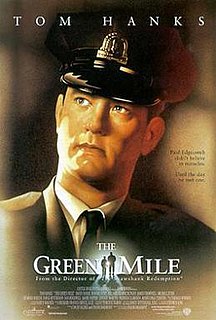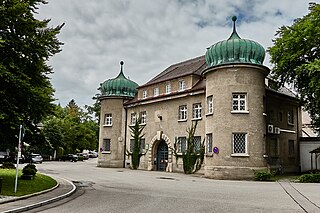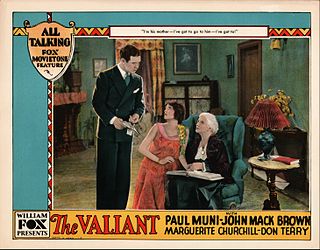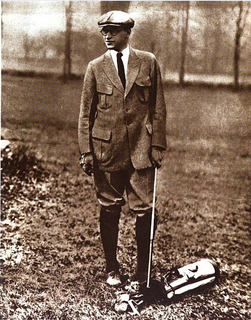
George Cooper Stevens was an American film director, producer, screenwriter and cinematographer. Films he produced were nominated for the Academy Award for Best Motion Picture six times while he had five nominations as Best Director, winning twice.

Dead Man Walking (1993) is a work of non-fiction by Sister Helen Prejean, a Roman Catholic nun and one of the Sisters of Saint Joseph of Medaille based in New Orleans. Arising from her work as a spiritual adviser to two convicted murderers on death row, the book is set largely at the Louisiana State Penitentiary (Angola) in West Feliciana Parish, Louisiana. It examines moral issues related to the men's acknowledgement of their crimes and to the state's use of the death penalty.

Albert Pierrepoint was an English hangman who executed between 434 and 600 people in a 25-year career that ended in 1956. His father Henry and uncle Thomas were official hangmen before him.

The Green Mile is a 1999 American fantasy drama film written and directed by Frank Darabont and based on Stephen King's 1996 novel of the same name. It stars Tom Hanks as a death row prison guard during the Great Depression who witnesses supernatural events following the arrival of an enigmatic convict at his facility. David Morse, Bonnie Hunt, Doug Hutchison and James Cromwell appear in supporting roles.

Ruth Brown Snyder was an American murderer. Her execution in the electric chair at New York's Sing Sing Prison in 1928 for the murder of her husband, Albert Snyder, was recorded in a well-publicized photograph.

Landsberg Prison is a penal facility in the town of Landsberg am Lech in the southwest of the German state of Bavaria, about 65 kilometres (40 mi) west-southwest of Munich and 35 kilometres (22 mi) south of Augsburg. It is best known as the prison where Adolf Hitler was held in 1924, after the failed Beer Hall Putsch in Munich, and where he dictated his memoirs Mein Kampf to Rudolf Hess.
The official title of "state electrician" was given to some American state executioners in states using the electric chair during the early 20th century, including the New York State electrician.

A Short Film About Killing is a 1988 drama film directed by Krzysztof Kieślowski and starring Mirosław Baka, Krzysztof Globisz, and Jan Tesarz. Written by Krzysztof Kieślowski and Krzysztof Piesiewicz, the film was expanded from Dekalog: Five of the Polish television series Dekalog. Set in Warsaw, Poland, the film compares the senseless, violent murder of an individual to the cold, calculated execution by the state. A Short Film About Killing won both the Jury Prize and the FIPRESCI Prize at the 1988 Cannes Film Festival, as well as the European Film Award for Best Film.

The Valiant is a 1929 American drama film released by Fox Film Corporation in the Fox Movietone sound-on-film system on May 19, 1929. It is produced and directed by William K. Howard and stars Paul Muni, Marguerite Churchill, and John Mack Brown. Although described by at least one source as a silent film containing talking sequences, synchronized music, and sound effects, The Valiant has continuous dialogue and is a full "talkie" made without a corresponding silent version.

Peter Elfelt was a Danish photographer and film director known as the first movie pioneer in Denmark when he began making documentary films in 1897.

Driving with Greenland Dogs,, is a Danish silent film made in 1897 by the photographer Peter Elfelt. It was the first movie sequence filmed in Denmark. The film, less than one minute in length, shows a Danish colony manager named Johan Carl Joensen driving a sledge pulled by Greenlandic sled dogs through Fælledparken in Copenhagen, Denmark. In the short sequence, the dog sled is driven toward the camera across a flat snow-covered landscape, it disappears out of the picture, and then reappears from the other side with the driver chasing behind. Elfelt shot the film using a camera he had constructed from detailed plans that Elfelt obtained from the French inventor, Jules Carpentier.

Anne Palles was an alleged Danish witch. She was the last woman to be legally executed for sorcery in Denmark.

The Red Meadows is a 1945 Danish war drama directed by Bodil Ipsen and Lau Lauritzen Jr. based on resistance fighter Ole Valdemar Juul's 1945 novel of the same name. The film, starring Poul Reichhardt and Lisbeth Movin, is a suspense tale revolving around the memories of a Danish saboteur as he awaits his execution in a German war-time prison. Filmed in Denmark only months after the end of the German occupation during World War II, Red Meadows was a tribute to the Danish resistance fighters. The film received the Palme d'Or at the Cannes Film Festival and is considered a stylistic masterwork.

A Victim of the Mormons is a 1911 Danish silent thriller film directed by August Blom. The film was controversial for demonizing the Mormon religion, and its box-office success is cited for initiating a decade of anti-Mormon propaganda films in America. It tells the story of an attractive young woman who is seduced and kidnapped by a Mormon missionary, then forced to accompany him to Utah to become one of his wives. The film became a hit, partly due to the popularity of its star, Valdemar Psilander, and partly due to the publicity arising from objections by The Church of Jesus Christ of Latter-day Saints and its failed campaign to ban the film.
Death row, also known as condemned row, is a place in a prison that houses inmates awaiting execution after being convicted of a capital crime and sentenced to death. The term is also used figuratively to describe the state of awaiting execution, even in places where no special facility or separate unit for condemned inmates exists.

Daybreak is a 1948 drama by Riverside Studios – classified by some as 'British Noir' – directed by Compton Bennett and starring Eric Portman, Ann Todd and Maxwell Reed. It is based on a play by Monckton Hoffe.
Laughter in Hell is a 1933 American Pre-Code drama film directed by Edward L. Cahn and starring Pat O'Brien. The film's title was typical of the sensationalistic titles of many Pre-Code films. Adapted from the 1932 novel of the same name by Jim Tully, the film was inspired in part by I Am a Fugitive from a Chain Gang and was part of a series of films depicting men in chain gangs following the success of that film. O'Brien plays a railroad engineer who kills his wife and her lover in a jealous rage and is sent to prison. The movie received a mixed review in The New York Times upon its release. Although long considered lost, the film was recently preserved and was screened at the American Cinematheque in Hollywood, CA in October 2012.

Execution of Czolgosz with Panorama of Auburn Prison is a 1901 silent film produced by the Edison Studios arms of Edison Manufacturing Company. The film is a dramatic reenactment of the execution of Leon Czolgosz by electric chair at Auburn Correctional Facility following his 1901 conviction for the assassination of William McKinley. It is considered an important film in the history of cinema.
The American and the Queen is a 1910 American silent short drama produced by the Thanhouser Company. The film focuses on Maud, the fictional queen of Rumania, who is overthrown by her cousin, Rupert. Maud is thrown into prison after refusing the romantic advances of Rupert. She escapes with the aid of her lady-in-waiting and a priest. A wealthy American named Jack Walton, foils an assassination attempt on Maud and he falls in love with her. Maud is recaptured and set to be executed when the priest comes up with a plan to save her, by marrying Jack and Maud. The ceremony takes place through her cell window, and soon the United States military arrives to save the now wife of an American. Rupert is killed in the ensuing conflict. No known cast or production credits for the film is known. The film was released on November 11, 1910 and was met with neutral to negative reviews by critics. The patriotic element of the film was cited as likely being comical for European audiences and the film was also used as an example of an inappropriate example of American flag-waving. The film is presumed lost.

The Valiant is a one-act play from the 1920s by Holworthy Hall and Robert Middlemass. It became a popular play for local theater groups, and is still performed today.
















